#Advanced Composite Solar Sail System
Explore tagged Tumblr posts
Text
Those of you following the Advanced Composite Solar Sail System may have heard that its booms and sail are now deployed. It is receiving light pressure from the Sun to propel it through the Solar System. Like a test pilot in a new aircraft, NASA are now testing out just how it handles. Before deployment, the spacecraft was slowly tumbling and now the controllers will see if they can get it under control and under sail power. The reflectivity of the sail means it's an easy spot in the night sky, just fire up the NASA app to find out where to look.
Continue Reading.
#Science#Space#ACSSS#Advanced Composite Solar Sail System#Solar Sail#NASA#National Aeronautics and Space Administration
265 notes
·
View notes
Text
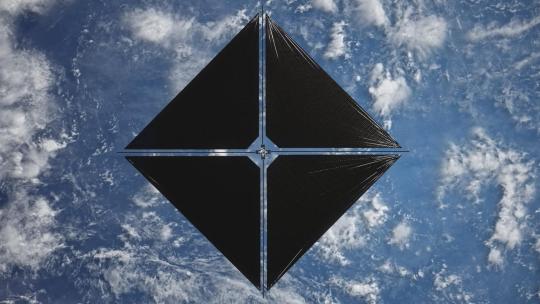
Setting Sail to Travel Through Space: 5 Things to Know about our New Mission
Our Advanced Composite Solar Sail System will launch aboard Rocket Lab’s Electron rocket from the company’s Launch Complex 1 in Māhia, New Zealand no earlier than April 23, at 6 p.m. EDT. This mission will demonstrate the use of innovative materials and structures to deploy a next-generation solar sail from a CubeSat in low Earth orbit.
Here are five things to know about this upcoming mission:
1. Sailing on Sunshine
Solar sails use the pressure of sunlight for propulsion much like sailboats harness the wind, eliminating the need for rocket fuel after the spacecraft has launched. If all goes according to plan, this technology demonstration will help us test how the solar sail shape and design work in different orbits.

2. Small Package, Big Impact
The Advanced Composite Solar Sail System spacecraft is a CubeSat the size of a microwave, but when the package inside is fully unfurled, it will measure about 860 square feet (80 square meters) which is about the size of six parking spots. Once fully deployed, it will be the biggest, functional solar sail system – capable of controlled propulsion maneuvers – to be tested in space.
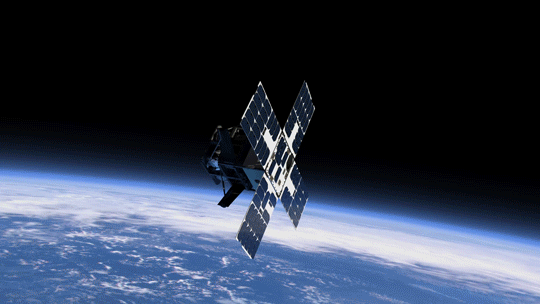
3. Second NASA Solar Sail in Space
If successful, the Advanced Composite Solar Sail System will be the second NASA solar sail to deploy in space, and not only will it be much larger, but this system will also test navigation capabilities to change the spacecraft’s orbit. This will help us gather data for future missions with even larger sails.
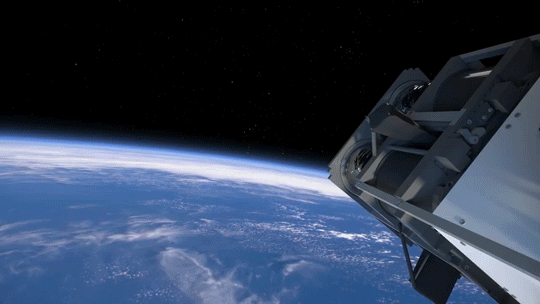
4. BOOM: Stronger, Lighter Booms
Just like a sailboat mast supports its cloth sails, a solar sail has support beams called booms that provide structure. The Advanced Composite Solar Sail System mission’s primary objective is to deploy a new type of boom. These booms are made from flexible polymer and carbon fiber materials that are stiffer and 75% lighter than previous boom designs. They can also be flattened and rolled like a tape measure. Two booms spanning the diagonal of the square (23 feet or about 7 meters in length) could be rolled up and fit into the palm of your hand!

5. It’s a bird...it’s a plane...it’s our solar sail!
About one to two months after launch, the Advanced Composite Solar Sail System spacecraft will deploy its booms and unfurl its solar sail. Because of its large size and reflective material, the spacecraft may be visible from Earth with the naked eye if the lighting conditions and orientation are just right!
To learn more about this mission that will inform future space travel and expand our understanding of our Sun and solar system, visit https://www.nasa.gov/mission/acs3/.
Make sure to follow us on Tumblr for your regular dose of space!
2K notes
·
View notes
Text
Tonight, there's a partial lunar eclipse which will be passing over the supermoon which should be visible with the naked eye. It'll begin at around 8:41 EST and peak at 10:44 EST which will be the best time to see it. For more information on the timing, Forbes has a nice guide.
Now, this is a lunar eclipse, which is when the moon is in such a position that the earth blocks the sun, creating a shadow on the moon. You won't need viewing glasses like you would with a solar eclipse, since it's still just light reflecting off the moon that you're seeing, rather than staring directly at the sun.
The eclipse will likely be fairly subtle, like holding your finger over the edge of the moon. But you won't get to see another one until March, so if you're itching to see an eclipse, this'll be the one for you.
As a bonus, keep an eye out for NASA's advanced composite solar sail system (ACS3) moving across the sky. You can find sighting opportunities on NASA's app. It'll appear as a bright, square-ish object that travels fairly quickly across the sky. It may only be around for a few minutes at a time, so it might be hard to catch, but it's worth the search if you're willing to track it.
104 notes
·
View notes
Text

New SpaceTime out Wednesday
SpaceTime 20240911 Series 27 Episode 110
Gigantic asteroid impact shifted Ganymede’s axis
A new study claims that the solar system’s largest moon, the Jovian giant Ganymede, was hit by a massive asteroid four billion years ago shifting its axis.




New way to measure the spin of a supermassive black hole
Astronomers have found a new way to measure how fast a black hole spins, by using the wobbly aftermath from its stellar feasting.
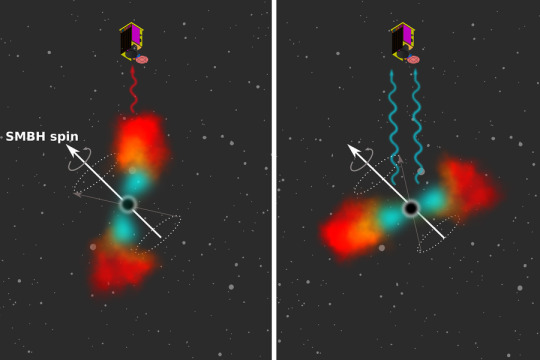
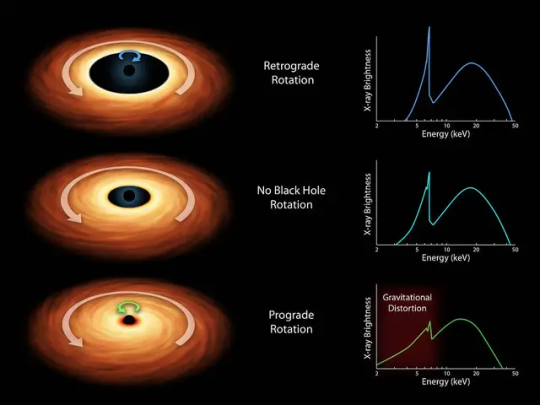


Nasa’s solar sail mission tumbling in orbit
NASA says its Advanced Composite Solar Sail System spacecraft is "tumbling or wobbling" through space, which may have impacted its orbit.

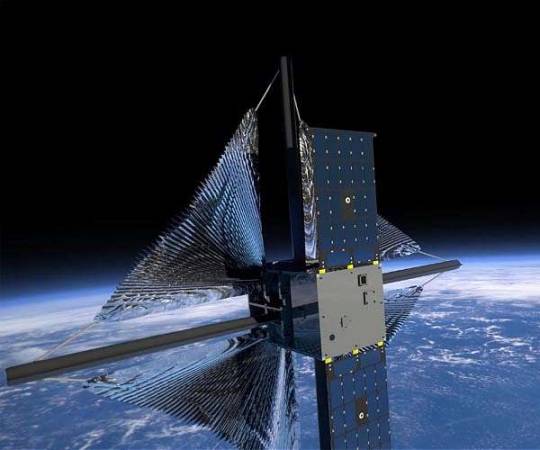
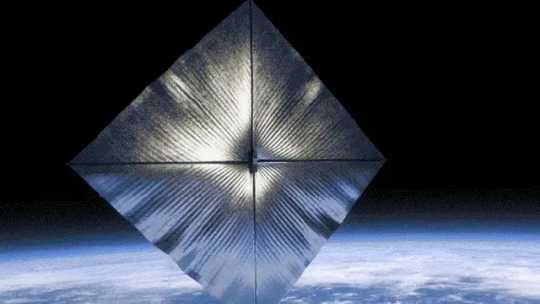
The Science Report
Semaglutide found to reduce the risk of heart failure.
Semaglutide also found to reduce the risk of dying from any cause including COVID-19.
Claims current screentime before sleep recommendations for kids are neither achievable nor appropriate.
Alex on Tech Apple’s i-phone 16

SpaceTime covers the latest news in astronomy & space sciences.
The show is available every Monday, Wednesday and Friday through Apple Podcasts (itunes), Stitcher, Google Podcast, Pocketcasts, SoundCloud, Bitez.com, YouTube, your favourite podcast download provider, and from www.spacetimewithstuartgary.com
SpaceTime is also broadcast through the National Science Foundation on Science Zone Radio and on both i-heart Radio and Tune-In Radio.
SpaceTime daily news blog: http://spacetimewithstuartgary.tumblr.com/
SpaceTime facebook: www.facebook.com/spacetimewithstuartgary
SpaceTime Instagram @spacetimewithstuartgary
SpaceTime twitter feed @stuartgary
SpaceTime YouTube: @SpaceTimewithStuartGary
SpaceTime -- A brief history
SpaceTime is Australia’s most popular and respected astronomy and space science news program – averaging over two million downloads every year. We’re also number five in the United States. The show reports on the latest stories and discoveries making news in astronomy, space flight, and science. SpaceTime features weekly interviews with leading Australian scientists about their research. The show began life in 1995 as ‘StarStuff’ on the Australian Broadcasting Corporation’s (ABC) NewsRadio network. Award winning investigative reporter Stuart Gary created the program during more than fifteen years as NewsRadio’s evening anchor and Science Editor. Gary’s always loved science. He studied astronomy at university and was invited to undertake a PHD in astrophysics, but instead focused on his career in journalism and radio broadcasting. Gary’s radio career stretches back some 34 years including 26 at the ABC. He worked as an announcer and music DJ in commercial radio, before becoming a journalist and eventually joining ABC News and Current Affairs. He was part of the team that set up ABC NewsRadio and became one of its first on air presenters. When asked to put his science background to use, Gary developed StarStuff which he wrote, produced and hosted, consistently achieving 9 per cent of the national Australian radio audience based on the ABC’s Nielsen ratings survey figures for the five major Australian metro markets: Sydney, Melbourne, Brisbane, Adelaide, and Perth. The StarStuff podcast was published on line by ABC Science -- achieving over 1.3 million downloads annually. However, after some 20 years, the show finally wrapped up in December 2015 following ABC funding cuts, and a redirection of available finances to increase sports and horse racing coverage. Rather than continue with the ABC, Gary resigned so that he could keep the show going independently. StarStuff was rebranded as “SpaceTime”, with the first episode being broadcast in February 2016. Over the years, SpaceTime has grown, more than doubling its former ABC audience numbers and expanding to include new segments such as the Science Report -- which provides a wrap of general science news, weekly skeptical science features, special reports looking at the latest computer and technology news, and Skywatch – which provides a monthly guide to the night skies. The show is published three times weekly (every Monday, Wednesday and Friday) and available from the United States National Science Foundation on Science Zone Radio, and through both i-heart Radio and Tune-In Radio.
#science#space#astronomy#physics#news#nasa#astrophysics#esa#spacetimewithstuartgary#starstuff#spacetime#jwst#hubble space telescope
7 notes
·
View notes
Text
NASA Next-Generation Solar Sail Boom Technology Ready for Launch
Sailing through space might sound like something out of science fiction, but the concept is no longer limited to books or the big screen. In April, a next-generation solar sail technology – known as the Advanced Composite Solar Sail System – will launch aboard Rocket Lab’s Electron rocket from the company’s Launch Complex 1 in Māhia, New Zealand. The technology could advance future space travel…

View On WordPress
5 notes
·
View notes
Text
NASA Ames Astrogram March/April 2024
Advanced Composite Solar Sail System Successfully Launches On April 23, the Advanced Composite Solar Sail System CubeSat mission launched successfully aboard an Electron rocket launched by Rocket Lab and carried Ames’ payload from Māhia, New Zealand. The CubeSat was subsequently delivered to a Sun-synchronous orbit around Earth. Ames has pioneered the use of CubeSats and small […] from NASA https://ift.tt/GwOpqW0
2 notes
·
View notes
Link
Washington DC (UPI) Apr 22, 2024 NASA is gearing up for a launch this week that will test a new way to navigate the solar system, using a large sail to catch the sunlight. The Advanced Composite Solar Sail System is scheduled to lift off Wednesday in New Zealand aboard a Rocket Lab Electron rocket from NASA's Complex 1 on the Mahia Peninsula. "We can sail, we can sail with solar sail tech, launching no earlier t
2 notes
·
View notes
Text
NASA Technologies Named Among TIME Inventions of 2024 - NASA
New Post has been published on https://sunalei.org/news/nasa-technologies-named-among-time-inventions-of-2024-nasa/
NASA Technologies Named Among TIME Inventions of 2024 - NASA
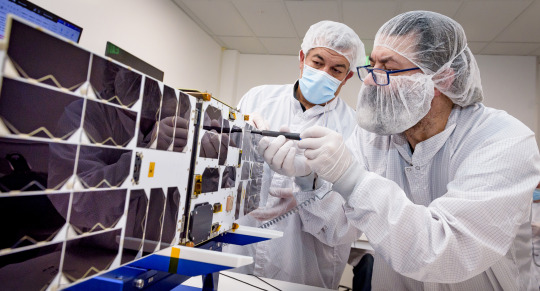
As NASA continues to innovate for the benefit of humanity, agency inventions that use new structures to harness sunlight for space travel, enable communications with spacecraft at record-breaking distances, and determine the habitability of a moon of Jupiter, were named Wednesday among TIME’s Inventions of 2024.
“The NASA workforce — wizards, as I call them — have been at the forefront of invention and technology for more than 65 years,” said NASA Administrator Bill Nelson. “From developing Europa Clipper, the largest satellite for a planetary mission that NASA has ever launched, to the Advanced Composite Solar Sail System, and communicating with lasers from deep space, NASA is improving our understanding of life on Earth — and the cosmos — for the benefit of all.”
Solar Sailing with Composite Booms
NASA’s Advanced Composite Solar Sail System is testing technologies that could allow spacecraft to “sail on sunlight,” using the Sun’s rays for propulsion. Like a sailboat turning to catch the wind, a solar sail adjusts its trajectory by angling its sail supported by booms deployed from the spacecraft. This demonstration uses a composite boom technology that is stiffer, lighter, and more stable in challenging thermal environments than previous designs. After launching on April 23, aboard Rocket Lab’s Electron rocket, the mission team met its primary objective by deploying the boom and sail system in space in August. Next, they will work to prove performance by using the sail to maneuver in orbit.
Results from this mission could provide an alternative to chemical and electric propulsion systems and inform the design of future larger-scale missions that require unique vantage points, such as space weather early warning satellites.
Communicating with Lasers from Deep Space
Since launching aboard NASA’s Psyche spacecraft on Oct. 13, 2023, a Deep Space Optical Communications technology demonstration has delivered record-breaking downlink data rates to ground stations as the Psyche spacecraft travels through deep space. To demonstrate the high data rates that are possible with laser communications, photos, telemetry data from the spacecraft, and ultra-high-definition video, including a streamed video of Taters the cat chasing a laser pointer, have been downlinked over hundreds of millions of miles. The mission, which is managed by NASA’s Jet Propulsion Laboratory in Southern California, has also sent and received optical communications out to Mars’ farthest distance from Earth, fulfilling one of the project’s primary goals.
Searching for Life’s Ingredients at Jupiter’s Icy Moon Europa
The largest NASA spacecraft ever built for a mission headed to another planet, Europa Clipper also is the agency’s first mission dedicated to studying an ocean world beyond Earth. Using a suite of nine science instruments and a gravity experiment, the mission seeks to determine whether Jupiter’s moon, Europa, has conditions that could support life. There’s strong evidence that under Europa’s ice lies an enormous, salty ocean. Scientists also have found evidence that Europa may host organic compounds and energy sources under its surface. Managed by NASA’s Jet Propulsion Laboratory, the spacecraft launched on Oct. 14, and will begin orbiting Jupiter in 2030, flying by the icy moon 49 times to learn more about it.
Europa Clipper’s main science objectives are to determine the thickness of the moon’s icy shell and its interactions with the ocean below, to investigate its composition, and to characterize its geology. The detailed exploration will help scientists better understand the astrobiological potential for habitable worlds beyond our planet.
NASA’s Ames Research Center in California’s Silicon Valley manages the Advanced Composite Solar Sail System, and NASA’s Langley Research Center in Hampton, Virginia, designed and built the deployable composite booms and solar sail system. Within NASA’s Space Technology Mission Directorate (STMD), the Small Spacecraft Technology program funds and manages the mission and the Game Changing Development program developed the deployable composite boom technology.
The Deep Space Optical Communications experiment is funded by STMD’s Technology Demonstration Missions Program managed at NASA’s Marshall Space Flight Center in Huntsville, Alabama, and the agency’s Space Communications and Navigation program within the Space Operations Mission Directorate. Some of the technology was developed through NASA’s Small Business Innovation Research program.
Managed by Caltech in Pasadena, California, NASA’s Jet Propulsion Laboratory leads the development of the Europa Clipper mission in partnership with Johns Hopkins Applied Physics Laboratory in Laurel, Maryland for NASA’s Science Mission Directorate. The Applied Physics Laboratory designed the main spacecraft body in collaboration with the Jet Propulsion Laboratory as well as NASA’s Goddard Space Flight Center in Greenbelt, Maryland, NASA Marshall, and NASA Langley.
For more information about the agency’s missions, visit:
https://www.nasa.gov
0 notes
Text
The Role of Carbon Fiber Molds, Composite Molds, and Compression Molds in Space Exploration Technologies

Carbon Fiber Molds: Lightweight and High-Strength Components
Carbon fiber molds are instrumental in creating lightweight and high-strength parts, especially in aerospace where every gram of weight matters. Carbon fiber composites are made by weaving carbon fibers into a fabric, which is then combined with a resin and cured in a mold to form solid structures. These molds are crucial for producing components like solar sails, as demonstrated by the ACS3 mission.
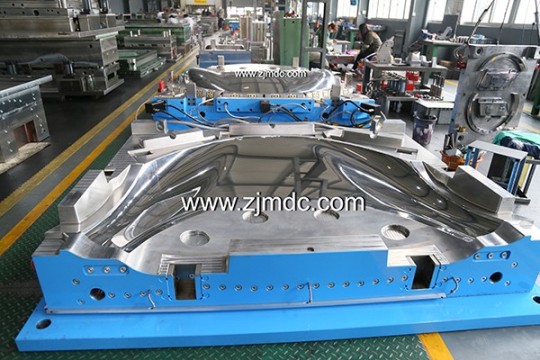
Composite Molds: Versatile and Durable
Composite molds combine materials such as carbon, glass, and aramid fibers embedded in a resin matrix, resulting in versatile molds capable of withstanding high temperatures and pressures. These molds provide significant advantages in aerospace, as they enable the manufacturing of large, complex structures with precision.
The ACS3 solar sail system is a testament to the power of composite materials in space. Composite molding allows for the construction of durable, lightweight components that can be maneuvered and controlled in space, maximizing the effectiveness of solar sails. Other industries, such as renewable energy and automotive, also benefit greatly from composite molding processes.
Compression Molds: Efficiency and Precision in Production
Compression molds are widely used in high-volume manufacturing processes. The compression molding process involves placing preheated materials into a mold, where they are shaped under pressure. This method allows for the rapid production of identical parts with high precision, making it ideal for industries like aerospace, where strength and durability are essential.

The Future of Molding Technologies in Aerospace
The successful ACS3 mission illustrates the growing importance of carbon fiber molds, composite molds, and compression molds in space exploration. These technologies not only push the boundaries of aerospace but also offer innovations that will impact a variety of industries. As engineers continue to refine these processes, the use of advanced molding techniques will become even more widespread.
Industries aiming to reduce weight, improve efficiency, and lower production costs will increasingly turn to carbon fiber molding and composite molding techniques. The durability and versatility of these materials make them ideal for applications ranging from space technologies to automotive and industrial manufacturing.
Conclusion
The advancement of space technologies like NASA’s ACS3 system highlights the critical role of carbon fiber molds, composite molds, and compression molds. These innovative materials and molding techniques enable the creation of lightweight, durable, and efficient components that are shaping the future of space exploration and manufacturing industries. By adopting these advanced processes, industries can develop cost-effective solutions for their most challenging applications.
#compression tooling#compression mold#smc mold#bmc mold#bmc tooling#smc tooling#composite mold#compression molding
0 notes
Text
Ok I was able to catch maybe the teeniest tiniest glimpse of the solar sail before it was immediately hidden behind clouds but that is not enough for me. I need a clear shot of this tennis court sized sheet of mylar in the sky. I need her in my life.
If you also would like to go insane over what is ostensibly a big sheet of foil propelled by the sun download the NASA app, go to "featured missions," and select the Advanced Composite Solor Sail System (ACS3). She's my everything.
1 note
·
View note
Text
NASA revela la primera imagen de la vela solar gigante en el espacio
Ha publicado la primera imagen la @NASA de su vela solar espacial gigante ajustable para dar propulsión a un cubeSat.
Agencias, Ciudad de México.- La NASA ha publicado la primera imagen de su vela solar espacial gigante ajustable, lanzada en abril para dar propulsión a un cubeSat y que se desplegó por completo el 29 de agosto. Conocida como Advanced Composite Solar Sail System, la nave espacial continúa enviando imágenes y datos, lo que ayuda al equipo a comprender mejor cómo funcionó la demostración de la…
0 notes
Text
Vela solar da NASA entra em operação e abre caminho para missões mais longas e econômicas
Após mais de quatro meses de espera, a NASA confirmou o sucesso na implantação de sua vela solar, chamada Advanced Composite Solar Sail System (ACS3). Lançada ao espaço em 24 de abril por um foguete da Rocket Lab, a vela só foi totalmente aberta em agosto, quando a agência espacial verificou que o dispositivo estava completamente operacional. A vela solar é uma tecnologia inovadora que utiliza a…

View On WordPress
0 notes
Text
NASA's Advanced Composite Solar Sail System Successfully Deploys in Space | Daily Reports Online
After more than four months in space, NASA’s Advanced Composite Solar Sail System (ACS3) has successfully deployed its solar sail. The spacecraft, which launched aboard Rocket Lab’s Electron vehicle on April 24, reached a significant milestone at the end of August. NASA announced that the mission operators confirmed the sail’s full deployment on August 29 at 1:33 pm EDT. The sail, which functions…
0 notes
Text
Excellence in Architectural Design: Crafting Iconic Structures Worldwide

Introduction
Architecture, the art and science of designing and constructing buildings, plays a crucial role in shaping the environments where we live, work, and play. It reflects the culture, values, and technological advancements of societies throughout history. Today, excellence in architectural design is characterized by innovation, sustainability, and the ability to create iconic structures that stand the test of time. This blog explores the principles and practices that define outstanding architectural design, examining some of the most iconic structures around the world and the elements that make them exemplary.
The Foundations of Architectural Excellence
Innovation and Creativity
At the heart of exceptional architectural design is innovation. Architects push the boundaries of traditional building methods, materials, and aesthetics to create structures that are not only functional but also visually stunning. This creativity leads to unique designs that can transform skylines and become landmarks.
Unique Shapes and Forms: Modern architecture often features bold, unconventional shapes that challenge the norms of symmetry and form. These designs can evoke emotions and create a sense of wonder.
Advanced Materials: The use of new materials such as carbon fiber, smart glass, and sustainable composites allows architects to experiment with designs that were previously impossible. Check architecture maroc.
Functionality and Practicality
While aesthetic appeal is important, functionality remains a cornerstone of excellent architectural design. A building must meet the needs of its users, providing spaces that are practical, safe, and comfortable.
Ergonomic Design: Incorporating ergonomic principles ensures that buildings are user-friendly, promoting efficiency and well-being.
Adaptive Use: Designing structures that can adapt to changing needs over time increases their longevity and relevance.
Sustainability and Environmental Considerations
In the contemporary architectural landscape, sustainability is a critical factor. Architects are increasingly focused on creating buildings that minimize environmental impact and promote sustainability.
Energy Efficiency: Utilizing energy-efficient systems, such as solar panels, green roofs, and advanced insulation, reduces a building's carbon footprint.
Sustainable Materials: Choosing materials that are renewable, recycled, or have a low environmental impact helps conserve natural resources.
Iconic Structures Around the World
The Sydney Opera House
The Sydney Opera House, with its distinctive sail-like design, is one of the most recognizable structures globally. Designed by Danish architect Jørn Utzon, it exemplifies how innovative design can create a national icon.
Innovative Design: The Opera House's design was revolutionary for its time, featuring a series of large precast concrete shells.
Cultural Significance: It serves as a cultural hub, hosting performances and events that attract visitors from around the world.
The Burj Khalifa
Standing as the tallest building in the world, the Burj Khalifa in Dubai is a marvel of modern engineering and design. Designed by the architectural firm SOM, it exemplifies the pinnacle of skyscraper design.
Structural Ingenuity: The building's Y-shaped cross-section provides stability and maximizes views, making it an engineering masterpiece.
Sustainability Features: Despite its size, the Burj Khalifa incorporates sustainable practices, such as a condensate recovery system that collects water from the building's cooling system.
The Guggenheim Museum Bilbao
Frank Gehry's design for the Guggenheim Museum in Bilbao, Spain, is a testament to the transformative power of architecture. Its undulating, organic forms have revitalized the city and attracted international acclaim.
Artistic Expression: The museum's design blurs the lines between architecture and sculpture, creating a dynamic and engaging space.
Urban Impact: The Guggenheim's success has spurred economic and cultural revitalization in Bilbao, demonstrating the broader impact of innovative architecture.
The Role of Technology in Modern Architecture
Digital Design Tools
The advent of digital design tools has revolutionized the field of architecture. Software such as CAD (Computer-Aided Design) and BIM (Building Information Modeling) allows architects to create precise, complex designs with greater efficiency.
Precision and Accuracy: Digital tools enable detailed planning and simulation, reducing errors and ensuring that designs are feasible.
Collaboration and Integration: BIM facilitates collaboration among architects, engineers, and contractors, integrating all aspects of the building process.
Smart Building Technologies
Smart technologies are increasingly being integrated into architectural designs, enhancing functionality and user experience.
Automation Systems: Building automation systems control lighting, HVAC, security, and other functions, improving efficiency and convenience.
Internet of Things (IoT): IoT devices collect and analyze data to optimize building performance and maintenance.
Sustainable Design Practices
Passive Design Strategies
Passive design strategies aim to reduce energy consumption by maximizing natural light, ventilation, and thermal regulation.
Natural Lighting: Large windows, skylights, and light wells are used to illuminate interiors naturally, reducing the need for artificial lighting.
Ventilation: Designing for natural ventilation helps maintain indoor air quality and reduces reliance on air conditioning.
Renewable Energy Integration
Incorporating renewable energy sources into architectural designs is becoming standard practice.
Solar Panels: Photovoltaic panels can be integrated into roofs and facades, generating clean energy for the building.
Wind Turbines: Some modern buildings incorporate wind turbines to harness wind energy, particularly in high-rise structures.
The Future of Architectural Design
Biophilic Design
Biophilic design emphasizes the connection between humans and nature, integrating natural elements into built environments to enhance well-being.
Green Spaces: Incorporating gardens, green roofs, and living walls brings nature into urban settings.
Natural Materials: Using materials like wood, stone, and bamboo creates a warm, organic aesthetic.
Modular and Prefabricated Construction
Modular and prefabricated construction methods offer efficiency and flexibility, allowing for rapid assembly and customization.
Time and Cost Efficiency: Prefabrication reduces construction time and costs by manufacturing components off-site.
Quality Control: Factory-controlled environments ensure high quality and precision in building components.
Adaptive Reuse and Urban Regeneration
Adaptive reuse involves repurposing existing buildings for new functions, preserving architectural heritage while meeting modern needs.
Historical Preservation: Retaining historical elements maintains cultural heritage and adds character to urban landscapes.
Sustainability: Reusing structures reduces demolition waste and conserves resources.
Conclusion
Excellence in architectural design is a multifaceted pursuit, encompassing innovation, functionality, sustainability, and aesthetic appeal. As architects continue to push the boundaries of what is possible, they create iconic structures that inspire and transform. From the sleek lines of modern skyscrapers to the organic forms of cultural landmarks, these buildings stand as testaments to human ingenuity and creativity. As we look to the future, the integration of advanced technologies, sustainable practices, and a deep connection to nature will continue to shape the evolution of architectural design, crafting spaces that enrich our lives and reflect our aspirations.
0 notes
Text
NASA to Hoist Its Sail: Solar Sail Mission Gets Ready for Launch
A NASA mission testing a new way of navigating our solar system is ready to hoist its sail into space – not to catch the wind, but the propulsive power of sunlight. The Advanced Composite Solar Sail System is targeting launch on Tuesday, April 23 (Wednesday, April 24 in New Zealand) aboard a Rocket Lab Electron rocket from the company’s Launch Complex 1 on the Mahia Peninsula of New…

View On WordPress
0 notes